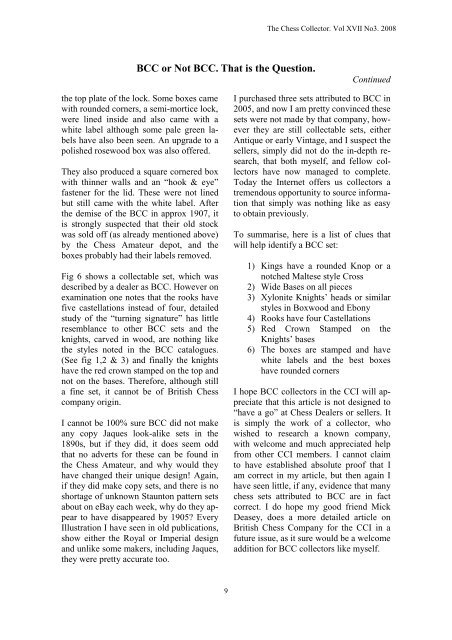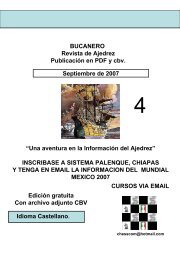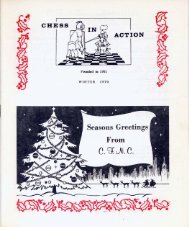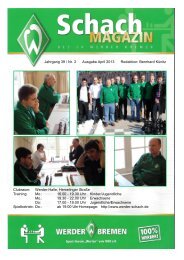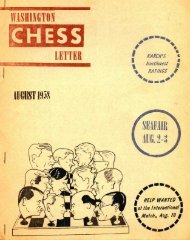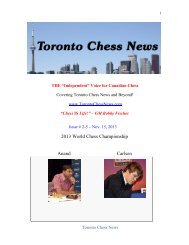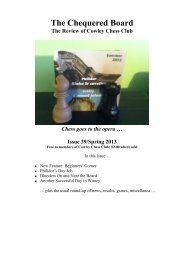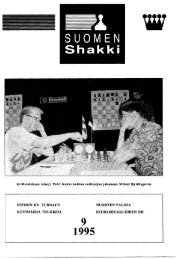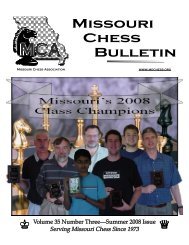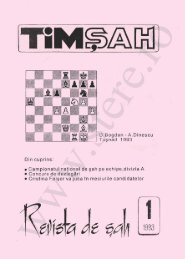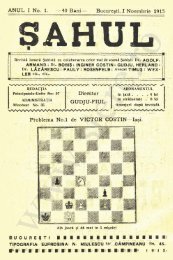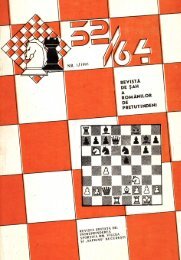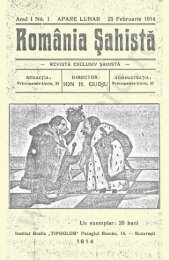The Chess Collector
El ajedrez es un juego, considerado un deporte, entre dos personas, cada una de las cuales dispone de 16 piezas móviles que se colocan sobre un tablero dividido en 64 escaques. En su versión de competición está considerado como un deporte.
El ajedrez es un juego, considerado un deporte, entre dos personas, cada una de las cuales dispone de 16 piezas móviles que se colocan sobre un tablero dividido en 64 escaques. En su versión de competición está considerado como un deporte.
You also want an ePaper? Increase the reach of your titles
YUMPU automatically turns print PDFs into web optimized ePapers that Google loves.
<strong>The</strong> <strong>Chess</strong> <strong>Collector</strong>. Vol XVII No3. 2008<br />
BCC or Not BCC. That is the Question.<br />
Continued<br />
the top plate of the lock. Some boxes came<br />
with rounded corners, a semi-mortice lock,<br />
were lined inside and also came with a<br />
white label although some pale green labels<br />
have also been seen. An upgrade to a<br />
polished rosewood box was also offered.<br />
<strong>The</strong>y also produced a square cornered box<br />
with thinner walls and an “hook & eye”<br />
fastener for the lid. <strong>The</strong>se were not lined<br />
but still came with the white label. After<br />
the demise of the BCC in approx 1907, it<br />
is strongly suspected that their old stock<br />
was sold off (as already mentioned above)<br />
by the <strong>Chess</strong> Amateur depot, and the<br />
boxes probably had their labels removed.<br />
Fig 6 shows a collectable set, which was<br />
described by a dealer as BCC. However on<br />
examination one notes that the rooks have<br />
five castellations instead of four, detailed<br />
study of the “turning signature” has little<br />
resemblance to other BCC sets and the<br />
knights, carved in wood, are nothing like<br />
the styles noted in the BCC catalogues.<br />
(See fig 1,2 & 3) and finally the knights<br />
have the red crown stamped on the top and<br />
not on the bases. <strong>The</strong>refore, although still<br />
a fine set, it cannot be of British <strong>Chess</strong><br />
company origin.<br />
I cannot be 100% sure BCC did not make<br />
any copy Jaques look-alike sets in the<br />
1890s, but if they did, it does seem odd<br />
that no adverts for these can be found in<br />
the <strong>Chess</strong> Amateur, and why would they<br />
have changed their unique design! Again,<br />
if they did make copy sets, and there is no<br />
shortage of unknown Staunton pattern sets<br />
about on eBay each week, why do they appear<br />
to have disappeared by 1905? Every<br />
Illustration I have seen in old publications,<br />
show either the Royal or Imperial design<br />
and unlike some makers, including Jaques,<br />
they were pretty accurate too.<br />
I purchased three sets attributed to BCC in<br />
2005, and now I am pretty convinced these<br />
sets were not made by that company, however<br />
they are still collectable sets, either<br />
Antique or early Vintage, and I suspect the<br />
sellers, simply did not do the in-depth research,<br />
that both myself, and fellow collectors<br />
have now managed to complete.<br />
Today the Internet offers us collectors a<br />
tremendous opportunity to source information<br />
that simply was nothing like as easy<br />
to obtain previously.<br />
To summarise, here is a list of clues that<br />
will help identify a BCC set:<br />
1) Kings have a rounded Knop or a<br />
notched Maltese style Cross<br />
2) Wide Bases on all pieces<br />
3) Xylonite Knights’ heads or similar<br />
styles in Boxwood and Ebony<br />
4) Rooks have four Castellations<br />
5) Red Crown Stamped on the<br />
Knights’ bases<br />
6) <strong>The</strong> boxes are stamped and have<br />
white labels and the best boxes<br />
have rounded corners<br />
I hope BCC collectors in the CCI will appreciate<br />
that this article is not designed to<br />
“have a go” at <strong>Chess</strong> Dealers or sellers. It<br />
is simply the work of a collector, who<br />
wished to research a known company,<br />
with welcome and much appreciated help<br />
from other CCI members. I cannot claim<br />
to have established absolute proof that I<br />
am correct in my article, but then again I<br />
have seen little, if any, evidence that many<br />
chess sets attributed to BCC are in fact<br />
correct. I do hope my good friend Mick<br />
Deasey, does a more detailed article on<br />
British <strong>Chess</strong> Company for the CCI in a<br />
future issue, as it sure would be a welcome<br />
addition for BCC collectors like myself.<br />
9


